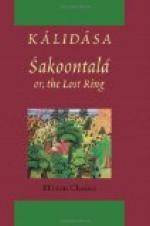The Hindu Cupid is said to have subdued a marine monster, which was, therefore, painted on his banner.
51 The graceful undulation of her gait.
Hansa-gamini, ‘walking like a swan,’ was an epithet for a graceful woman. The Indian lawgiver, Manu, recommends that a Brahman should choose for his wife a young maiden, whose gait was like that of a phoenicopter, or flamingo, or even like that of a young elephant. The idea in the original is, that the weight of her hips had caused the peculiar appearance observable in the print of her feet. Largeness of the hips was considered a great beauty in Hindu women, and would give an undulatory motion to their walk. 52 The Madhavi.
A large and beautiful creeper (Gaertnera racemosa), bearing white, fragrant flowers, to which constant allusion is made in Sanskrit plays.
53 Pines to be united with the Moon.
A complete revolution of the moon, with respect to the stars, being made in twenty-seven days, odd hours, the Hindus divide the heavens into twenty-seven constellations (asterisms) or lunar stations, one of which receives the moon for one day in each of his monthly journeys. As the Moon, Chandra, is considered to be a masculine deity, the Hindus fable these twenty-seven constellations as his wives, and personify them as the daughters of Daksha. Of these twenty-seven wives, twelve of whom give names to the twelve months, Chandra is supposed to show the greatest affection for the fourth, Rohini; but each of the others, and amongst them Vi[s’]akha, is represented as jealous of this partiality, and eager to secure the Moon’s favour for herself, Dushyanta probably means to compare himself to the Moon (he being of the Lunar race) and [S’]akoontala to Vi[s’]akha.
54. Checks its fall.
Owing to emaciation and disuse of the bow, the callosities on the forearm, usually caused by the bow-string, were not sufficiently prominent to prevent the bracelet from slipping down from the wrist to the elbow, when the arm was raised to support the head. This is a favourite idea with Kalidasa to express the attenuation caused by love.
55. No nuptial rites prevail.
A marriage without the usual ceremonies is called Gandharva. It was supposed to be the form of marriage prevalent among the nymphs of India’s heaven. In the 3rd Book of Manu (v. 22), it is included among the various marriage rites, and is said to be a union proceeding entirely from love, or mutual inclination, and concluded without any religious services, and without consulting relatives. It was recognized as a legal marriage by Manu and other lawgivers, though it is difficult to say in what respect it differed from unlawful cohabitation.
56. The loving birds doomed by fate to nightly separation.




